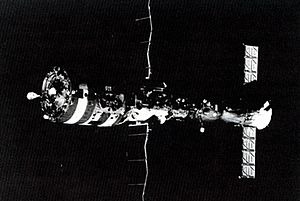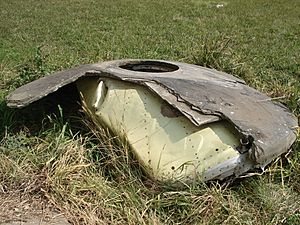Salyut 7 facts for kids
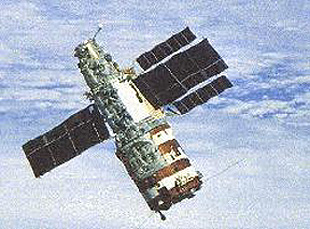
Salyut 7 photographed by Soyuz T-13 crew before docking, 25 September 1985
|
|
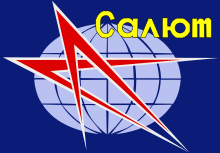
The insignia of the Salyut Program
|
|
| Station statistics | |
|---|---|
| Launch | 19 April 1982 19:45:00 UTC |
| Launch pad | LC-200/40, Baikonur Cosmodrome, Soviet Union |
| Reentry | 7 February 1991 |
| Mass | 19,824 kg |
| Length | 16 m (minimum) |
| Width | 4.15 m (max) |
| Pressurised volume | 90 m³ (minimum) |
| Perigee | 219 km (118.25 nmi) |
| Apogee | 278 km (150.1 nmi) |
| Orbital inclination | 51.6 degrees |
| Orbital period | 89.21minutes |
| Days in orbit | 3215 days |
| Days occupied | 816 days |
| No. of orbits | 51,917 |
| Distance travelled | 2,106,297,129 km (1,137,309,460 nmi) |
| Statistics as of de-orbit and reentry | |
| Configuration | |
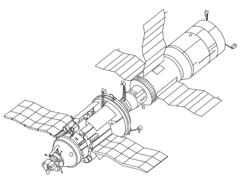
Salyut 7 with docked Kosmos 1686 TKS spacecraft
|
|
Salyut 7 (which means Salute 7 in Russian) was a space station that orbited Earth from April 1982 to February 1991. It was like a home and laboratory for astronauts in space.
The station was part of the Soviet Salyut programme. It launched on April 19, 1982, using a Proton rocket from the Baikonur Cosmodrome. Salyut 7 helped scientists learn how to connect different parts in space. This was important for building bigger space stations later on. It was the last station in the Salyut series before the Mir space station was built.
Contents
What Was Salyut 7 Like?
Salyut 7 was very similar to its older sibling, Salyut 6. It was launched because there were delays in building the Mir space station. Even though it had some technical problems, astronauts were able to fix them. For example, they had to repair a fuel leak in 1983 during spacewalks.
Salyut 7 stayed in orbit for almost nine years, which was a record at the time! Ten different crews visited it, including astronauts from France and India. One amazing moment was when Svetlana Savitskaya became the second woman in space. She was also the first woman to perform a spacewalk, where she even did metal cutting and welding!
Besides doing many experiments, Salyut 7 also tested how to connect large modules to a space station. These modules were like big additions that helped engineers learn how to build the much larger Mir station.
Inside Salyut 7
Salyut 7 had two docking ports, one at each end. These ports allowed other spacecraft, like Progress supply ships, to connect. It had three solar panels to get power from the sun. These panels could even have smaller panels attached to them for more power.
Inside, Salyut 7 was designed to be more comfortable for astronauts. It had electric stoves, a refrigerator, and constant hot water. The seats at the control console were redesigned to be more comfortable. There were also special windows that let in ultraviolet light to help kill germs. The areas for medical checks, biology experiments, and exercise were also improved.
Scientists also grew plants on Salyut 7 using special systems. In one experiment, a plant called Arabidopsis became the first plant to flower and produce seeds in space's zero gravity!
Salyut 7 was the most advanced and comfortable station in the Salyut series. It had about 20 windows with shades. The inside was painted with different colors like white, apple green, and beige. This was done by an architect named Galina Balashova. She wanted to make living in space feel more like home for the astronauts.
Who Visited Salyut 7?
Salyut 7 was visited by many different spacecraft and crews. Large modules like Kosmos 1443 and Kosmos 1686 also docked with the station. These modules were like extra rooms or labs.
Ten different Soyuz T crews worked on Salyut 7. Only two "guest cosmonauts" from other countries visited. One time, a launch of the Soyuz T-10-1 spacecraft had a problem on the launch pad. The crew was safely ejected and recovered.
Long-Stay Crews
Salyut 7 had six main crews who lived there for long periods.
- The first crew, Anatoli Berezovoy and Valentin Lebedev, stayed for 211 days in 1982.
- In 1983, Vladimir Lyakhov and Alexander Alexandrov spent 150 days on board.
- The longest stay was by Leonid Kizim, Vladimir Solovyov, and Oleg Atkov, who lived on Salyut 7 for 237 days in 1984.
- In 1985, Vladimir Dzhanibekov and Viktor Savinykh arrived to fix problems with the station.
- Later in 1985, Vladimir Vasyutin, Alexander Volkov, and Georgi Grechko visited.
- The last crew to visit Salyut 7 was Leonid Kizim and Vladimir Solovyov in 1986. They even flew from the Mir space station to Salyut 7 and back!
There were also four shorter visiting missions that brought supplies and helped the main crews.
Problems and Repairs in Space
Salyut 7 faced two big problems that needed amazing repairs in space.
Fuel Leaks
In September 1983, astronauts Vladimir Lyakhov and Alexander Alexandrov noticed a fuel leak. This was a serious problem! Ground control decided that the next crew would have to fix it.
Astronauts Leonid Kizim and Vladimir Solovyov took on this challenge. They performed four spacewalks to fix two leaks. A special tool was sent up later to fix a third leak. This was one of the most complex repairs ever done in space at that time.
Loss of Power
On February 11, 1985, Salyut 7 suddenly lost all power and went silent. The station was empty at the time. It started to tumble out of control. It was a huge challenge to fix it!
Astronauts Vladimir Dzhanibekov and Viktor Savinykh were sent on the Soyuz T-13 mission to save the station. When they arrived, Salyut 7 was dark and cold. They had to guide their spacecraft to dock with the tumbling station without any help from its systems.
Wearing warm clothes, they entered the freezing station. They found that an electrical sensor, which told the batteries when to charge, had failed. Once they replaced the batteries, the station slowly came back to life. Within a week, enough systems were working for supply ships to dock again. This rescue mission was so incredible that it inspired a 2017 Russian film called Salyut 7.
The End of Salyut 7
The last time Salyut 7 had astronauts on board was in 1986. The crew of Soyuz T-15 moved some equipment from Salyut 7 to the new Mir space station.
After that, Salyut 7 was boosted to a higher orbit to keep it from falling back to Earth too soon. The plan was to retrieve it later with a Buran shuttle. However, unexpected high solar activity made Earth's atmosphere thicker, which pulled the station down faster than expected.
Salyut 7 finally fell back to Earth on February 7, 1991. It broke apart over the town of Capitán Bermúdez in Argentina. Luckily, it missed its planned landing spot over the ocean, but no one was hurt.
Space Walks from Salyut 7
Astronauts on Salyut 7 performed many spacewalks (EVAs) to do repairs, add equipment, and conduct experiments.
| Mission | Spacewalker | Duration | What they did |
|---|---|---|---|
| Salyut 7 – PE-1 – EVA 1 | Lebedev, Berezevoi | 2 h, 33 min | Retrieved experiments |
| Salyut 7 – PE-2 – EVA 1 | Lyakhov, Alexandrov | 2 h, 50 min | Added a solar array |
| Salyut 7 – PE-2 – EVA 2 | Lyakhov, Alexandrov | 2 h, 55 min | Added another solar array |
| Salyut 7 – PE-3 – EVA 1 | Kizim, Solovyov | 4 h, 20 min | Repaired the fuel system |
| Salyut 7 – PE-3 – EVA 2 | Kizim, Solovyov | 4 h, 56 min | Continued fuel system repair |
| Salyut 7 – PE-3 – EVA 3 | Kizim, Solovyov | 2 h, 45 min | Continued fuel system repair |
| Salyut 7 – PE-3 – EVA 4 | Kizim, Solovyov | 2 h, 45 min | Continued fuel system repair |
| Salyut 7 – PE-3 – EVA 5 | Kizim, Solovyov | 3 h, 05 min | Added a solar array |
| Salyut 7 – VE-4 – EVA 1 | Savitskaya, Dzhanibekov | 3 h, 35 min | First spacewalk by a woman |
| Salyut 7 – PE-3 – EVA 6 | Kizim, Solovyov | 5 h, 00 min | Completed fuel system repair |
| Salyut 7 – PE-4 – EVA 1 | Dzhanibekov, Savinykh | 5 h, 00 min | Added more solar arrays |
| Salyut 7 – PE-6 – EVA 1 | Kizim, Solovyov | 3 h, 50 min | Tested a truss structure and collected samples |
| Salyut 7 – PE-6 – EVA 2 | Kizim, Solovyov | 5 h, 00 min | Continued testing the truss structure |
How Spacecraft Docked
Sometimes, a Soyuz spacecraft would need to move from one docking port to another on Salyut 7. This was done to make space for incoming Progress supply ships, which could only refuel the station from a specific port.
The resident crew would get into their Soyuz, undock, and fly a short distance away from Salyut 7. Then, ground control would command the station to slowly turn around 180 degrees. Finally, the Soyuz would fly back and dock with the other port. This tricky maneuver was successfully done by the crews of Soyuz T-7, T-9, and T-11.
Facts About Salyut 7
Here are some quick facts about the Salyut 7 space station:
- Length: About 16 meters (about the length of a large bus)
- Maximum diameter: 4.15 meters
- Inside space (habitable volume): 90 cubic meters (like a small apartment)
- Weight at launch: 19,824 kilograms (about 43,700 pounds)
- Launch vehicle: Proton rocket
- Solar arrays: 3 large panels, spanning 17 meters wide
- Electricity generated: 4.5 kilowatts (enough to power a few homes)
- Supply ships: Soyuz-T, Progress, and TKS spacecraft
- Docking ports: 2
- Total manned missions: 12
- Total unmanned missions: 15
- Longest missions: 6
- Main engines: 2
Images for kids
See also
 In Spanish: Saliut 7 para niños
In Spanish: Saliut 7 para niños



